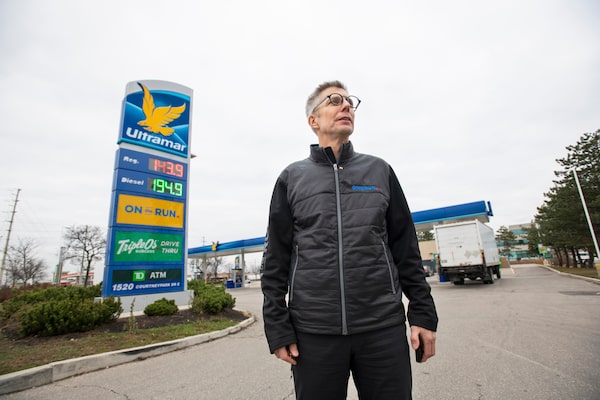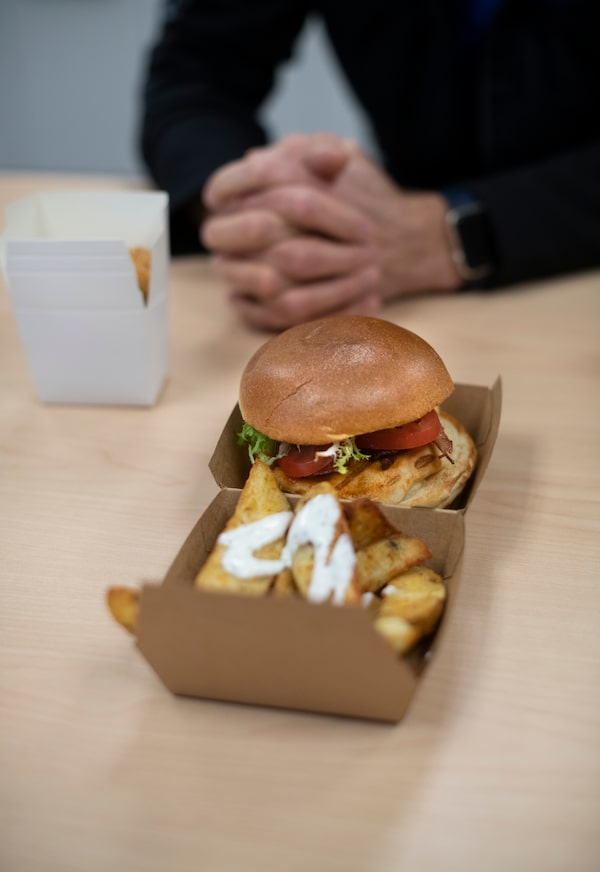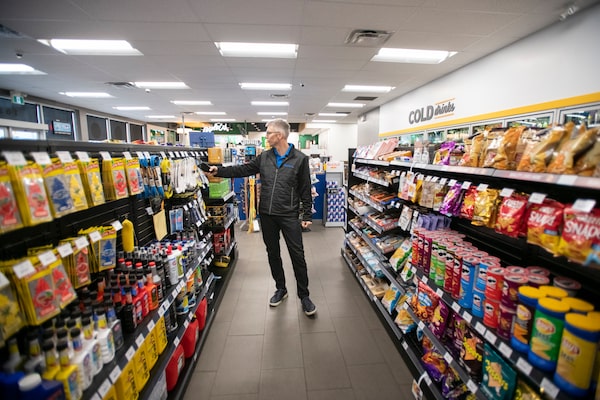
Bob Espey, President and Chief Executive Office of Parkland, at one of the company’s On the Run stores in Mississauga on Nov. 29, 2022.Fred Lum/The Globe and Mail
Last fall Bob Espey, the chief executive officer of Parkland Corp. PKI-T, stood near a maze of pipes at the company’s crude oil refinery in Burnaby, B.C., and explained how important the facility is to Parkland’s future. “The energy we produce and sell powers people’s lives every day,” he said.
Later, while sampling a new chipotle grilled chicken BLT at the Mississauga test kitchen of M&M Food Market, which Calgary-based Parkland also owns, he detailed why that division was also critical to the company’s prospects. “M&M plays a central role in our diversification strategy,” he said.
If hydrocarbons and hot sandwiches seem like a disjointed pairing, it speaks to the difficult position Parkland finds itself in today.
For years, Parkland enjoyed a winning strategy of buying up fuel station and convenience store chains in Canada, the United States and the Caribbean, and integrating them with its fuel supply and distribution network. But with the disruption to commuter driving habits from COVID-19 and the heightened investor focus on the shift from fossil fuels to cleaner energy sources – particularly the rise of electric vehicles (EVs) – Parkland’s carefully tuned operating model has come under intense pressure. The company’s share price is down roughly 40 per cent from its prepandemic peaks.
In many ways Parkland is the corporate embodiment of the awkward and at times contradictory transition from the traditional energy economy to an emerging low-carbon world, and Mr. Espey’s answer for Parkland is to take a page from the old and the new.

Parkland is transforming its stores into destination sites with fresh food offerings – including chicken sandwiches from M&M.Fred Lum/The Globe and Mail
While continuing to develop its core fuel business, Parkland is rolling out a network of ultrafast EV charging stations and transforming its stores into “destination sites” with fresh food offerings – including that chicken sandwich from M&M, a company Parkland acquired in January, 2022 – and where EV drivers can kick back while waiting for their vehicles to charge.
“There is more opportunity than threat in the energy transformation,” Mr. Espey said during a visit to the Burnaby refinery, a facility the company acquired from Chevron Canada in 2017 that is capable of refining 55,000 barrels a day of crude and now also co-processes 2,100 barrels a day of biofuel. “This is a massive once-in-a-generation opportunity to participate in an enormous amount of investment. If we can’t carve a niche out that is as big as Parkland is today or bigger, we’re not doing our job.”
It all leaves the head of Parkland – which used to be called Parkland Fuel Corp. until it changed its name in 2020 – treading a fine line. On one hand, Mr. Espey must convince investors that the company’s legacy fossil-fuel business isn’t in danger of being eroded by the energy transition as quickly as some people believe, while at the same time generating investor enthusiasm for the company’s plan to capitalize on what he says is society’s inevitable move away from fossil fuels.
Under Mr. Espey’s plan, Parkland will generate one-third of its EBITDA (earnings before interest, taxes, depreciation and amortization) from its retail diversification and commercial decarbonization efforts, up from a little over 10 per cent last year. The rest will come from the continued development of its conventional fuels business.
The markets are watching. “I hear investors asking, ‘Is Parkland an energy company or is it a food company?’” says Ben Isaacson, a Scotiabank analyst who has a “sector outperform” rating on the company. “The company has a lot of balls in the air they’re juggling and so investors, rightly or wrongly, have been scratching their heads trying to figure out what Parkland wants to be.”


Parkland is Canada’s second-largest convenience store and gas station owner, with close to 4,000 locations in Canada, the U.S. and the Caribbean. CEO Bob Espey visits one of the company’s On the Run locations in Mississauga.Fred Lum/The Globe and Mail
As Canada’s second-largest convenience store and gas station owner, Parkland carries out business under brands such as Ultramar, Pioneer, Chevron and On the Run, with close to 4,000 locations in Canada, the U.S. and the Caribbean.
But unlike Canada’s other slushy-and-gasoline-slinging giant, Alimentation Couche Tard Inc. and its Circle K chain, which Parkland is frequently compared to, the company also operates a vast fuel-supply network of railways, trucks and storage tanks, as well as commercial and wholesale fuel businesses.
Parkland has used that foundation to quickly extract value from its many acquisitions, 55 in all since 2010, including a deal to buy 156 Husky-brand gas stations, which closed last September. The result was a 16-fold increase in the company’s EBITDA – Parkland’s go-to metric for measuring results – since Mr. Espey, a soft-spoken former naval officer with short, tousled hair, took over as CEO in 2011. EBITDA is expected to top $1.6-billion for 2022.
Those results have made Parkland and Mr. Espey stars in the eyes of investors, with a stock market return that trumped even powerhouse Couche-Tard in the years leading up to the pandemic. Since then, Parkland’s performance has lagged far behind.
Part of Mr. Espey’s plan to reverse that is to address what he sees as the weak link in the EV experience: charging. Namely that there are too few charging stations, and nothing to do at many of them while waiting for a charge which, even with a fast charger, can take 20 minutes to an hour.
“Elon Musk cracked the code on performance, and with mass producers getting in, the cost of EV ownership is coming down. But the third part that needs to be unlocked is the experience, because the experience for the EV driver is terrible,” he said.

A Parkland electric vehicle charging port station in Kelowna, B.C., on July 2, 2022. Kelowna is one of 25 retail locations in B.C. and Alberta to participate in Parkland's EV charging network pilot project.The Globe and Mail
It’s a frustration Mr. Espey experienced firsthand. In the early months of the pandemic, Mr. Espey and another Parkland executive piled into the company’s Tesla electric car for a road trip from Calgary to Vancouver. The trip involved roughly two extra hours of the pair sitting around waiting at chargers with little in the way of amenities around, he said, pointing to a photo on his phone of one of the charging sites behind a dingy-looking building in an interior B.C. town. “My kids are always remarking that I have more pictures of gas stations on my phone than of them,” he said.
Last year, Parkland started constructing a high-density network of fast chargers at its existing fuel stations, hoping to address EV drivers’ range anxiety. In early December the company said it would double the size of its initial charging network to 50 locations from Vancouver Island to Calgary by early 2024.
Key to the decision, and other decarbonization efforts Parkland is embarking on, was taxpayer money: The federal and B.C. governments kicked in a combined $6.8-million to make the expansion happen.
But, above all, Parkland wants to turn its gas station stores into destinations, luring EV drivers in with lounges and restaurant meals while their vehicles charge. The company had already taken some steps toward its “convenience store as destination” model when it signed a deal to expand British Columbia’s popular Triple O’s burger chain to its gas station stores in Ontario, but because of pandemic delays, just four have opened so far.
The bet now is that fresh food offerings from M&M can be rolled out faster and with less overhead. Parkland bought the food retailer last January for $322-million, picking up 300 standalone stores and 2,000 “express” locations in other retailers.
M&M, which specializes in frozen meals, already has express freezers in some On the Run locations. But at its Mississauga headquarters, the company is testing more than two dozen hot food dishes that can be served to diners.
:format(jpeg)/cloudfront-us-east-1.images.arcpublishing.com/tgam/HUMSTZ6EWNBNTBJODOXVGMQBUQ.jpg)
:format(jpeg)/cloudfront-us-east-1.images.arcpublishing.com/tgam/CJQEJOQ5VFHXDPWRTL374ILEZM.jpg)
In its fresh food “war room,” whiteboards, tables and shelves teem with food photos, sticky notes, hand-scrawled messages and stacks of different types of packaging. Eventually the recipes will be sent out to M&M’s vendors – the company doesn’t manufacture any food itself – and the first eight locations are scheduled to open this year.
In buying M&M, Parkland also gained access to the 2.1 million active members of the company’s loyalty program, which will eventually be combined with Parkland’s own Journie loyalty program and its 3.8 million members. Eventually Mr. Espey envisions a time when EV drivers using the Journie smartphone app will plan their trips, book charging times and preorder their meals.
Still, malls and other restaurant chains are rolling out their own charging networks, giving EV owners plenty of options for where to charge. Mr. Espey admits the shift will widen the competitive landscape for Parkland. “But we have proven locations on proven highways where people come and are used to getting service,” he said. “We’ve learned a lot in the fuel industry that translates into servicing an EV customer who’s on the road who needs a quick turnaround and good amenities.”
Yet the question remains, as more EVs hit the road, can Parkland replace lost business from gasoline drivers dollar for dollar?
Parkland believes so, though it expects the customer traffic to its stores will change. Whereas a driver of a car with an internal combustion engine might visit a Parkland location 30 times in a year, and generate an average of $4.50 in “margin” per visit, the company projects that EV drivers will each show up just five to eight times a year, yet add $15 to $20 to the company’s bottom line per visit.
That fits with what Mr. Espey saw when he travelled to Norway last year to “get a glimpse into the future.” EVs now account for one in five vehicles on the road there, and make up roughly 80 per cent of new vehicle sales. He spoke with gas station operators who told him the decline in gasoline sales has been made up through higher “back court” sales – meaning merchandise and food inside stores – and fees for charging.
Even as Mr. Espey touts Parkland’s EV ambitions, he argues that the company’s gasoline supply and retail businesses have many years, if not decades, of life left in them.
For one thing, B.C. is something of a “petri dish” for the energy transition because it is so far ahead of other jurisdictions in mandating and incentivizing decarbonization initiatives. In many of the regions where Parkland does business in Canada, the U.S. and the Caribbean, EV adoption will be far slower, he said.
Mr. Isaacson at Scotiabank agrees. “Mass adoption of EVs is probably 10 years away, and I think investors have jumped the gun when it comes to Parkland’s share price,” he said.
Likewise, the heavy transport and aircraft sectors are even harder to decarbonize, which, Mr. Espey insists, bodes well for Parkland’s diesel and jet fuel businesses. “You can’t plea bargain with the economics and physics, which unfortunately still favour conventional fuels,” he said.
That hasn’t stopped the company from expanding renewable-fuel production at its Burnaby refinery in order to meet B.C’s Low Carbon Fuel Standard, which compels suppliers to gradually decrease the carbon intensity in their fuel. In recent years Parkland has done so by co-processing, or blending, renewable feedstocks such as canola and tallow (animal fats) with traditional petroleum products.
Then, last May, Mr. Espey trumpeted a $600-million plan to ramp up the plant’s output of low-carbon fuel, including the construction of a standalone renewable-diesel complex, only to see those plans thrown into uncertainty when U.S. President Joe Biden signed his Inflation Reduction Act (IRA) – and its significant incentives for America’s renewable fuels sector – into law.

Part of Mr. Espey’s plan is to address what he sees as the weak link in the EV experience: charging.Fred Lum/The Globe and Mail
In late November, Parkland took its case to Ottawa. Appearing before the House of Commons trade committee, Ryan Krogmeier, the company’s senior vice-president of supply, trading and refining, told MPs that without comparable incentives from Ottawa the refinery expansion would not succeed. Because of the IRA, “we will not be able to compete against U.S. production once our facility is up and running,” he said, while calling on the federal government to “level the playing field” with tax credits for low-carbon fuel producers.
It was yet another reminder of the extent to which Parkland finds itself caught amidst a growing tangle of national and international climate policies, ESG investing principles and political lobbying, and marks a departure from its history of growing the business through shrewd acquisitions.
As if investors needed another reason for unease, in November Parkland reported its adjusted EBITDA fell 10 per cent in the third quarter after the company’s U.S. wholesale fuel business was left holding excess inventory when pump prices tumbled.
Marcel Teunissen, Parkland’s chief financial officer, called the issue a “black swan event,” and the company has since reassured investors that it is on track to meet its mid-decade growth target of generating $2-billion in EBITDA, while reducing the leverage Parkland has built up from its many recent acquisitions.
As for Mr. Espey, he knows his job now is to return Parkland to delivering steady, reliable results, quarter after quarter.
“We let down our stakeholders and I take full accountability for that,” he said. “I believe we have a great plan, but there’s a bit of a show-me story now.”